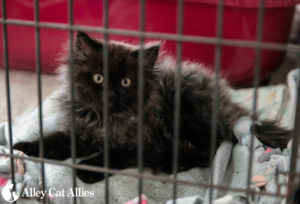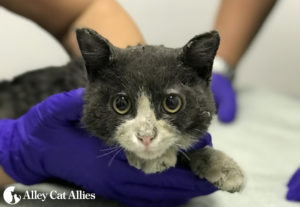Volunteers Out in Force to Save Cats
For hundreds of California’s “fire cats,” it’s out of the rubble and into the arms of rescue. If there is something positive to be gleaned from these raging wildfires and mudslides, which caused so much pain and destruction in California, it is this: You learn about the wonderful and devoted volunteers in your community who work on a daily basis, without recognition, to help people and animals. Now, in the aftermath of these disasters, those very same volunteers are out in force, doing what they always do.
Volunteers like Julie Linford of animal rescue group Outcast Cat Help (Julie is the founder and director), Jennifer Petruska of Pet Rescue and Reunification, Cathy Blackstone, and Suni Levi have been working tirelessly to bring a measure of comfort to those who’ve lost everything in the fires. They’re searching for the beloved pets who went missing amid the chaos.

A kitten is trapped and rescued following the California wildfires.
They are setting up night-vision cameras and hanging smelly socks soaked in mackerel juice on trees to lure and capture cats who may be too skittish, traumatized, or injured to come out of hiding.
Petruska dubbed these “fire cats,” and she has found some long after their owners had given up hope, she told The New York Times.
These efforts by volunteers and rescue groups, including Leslie Weiss, executive director and founder of Surfcat Rescue and Adoptions, will go on for weeks and even months. Cats who survived will continue to be found and reunited with their owners. And this is so important, because when you’ve lost everything, getting reunited with your beloved companion animal, who is like a member of the family, is extremely comforting. In all this sadness, pets help to calm and console us.
“When you see the reaction of someone who had thought their kitty had died, [and now they are reunited], it’s magical,” Weiss told us. “Nothing else matters to them now.”
Claudia Meglin’s family was reunited with their tabby Nemo after 87 days, thanks to Outcast volunteers who set up traps to capture him.
“I ended up losing everything in the fire, but the biggest pain was that we didn’t have Nemo with us. Evacuating without him was one of the hardest things I had to do. Now we’re back together, and I almost can’t believe it,” Meglin says.

Surfcat volunteers rescue Roni, who was injured by the wildfires.
Roni, Sebastian, and Evy are also among the countless cats who survived the flames. Four-month old Roni was burned so badly in the Thomas fire in Ventura and Santa Barbara Counties that she could barely walk. Her paws were blistered. Her fur was singed down to the skin. It was three weeks before rescuers located and trapped her. She’s now recovering in a foster home.
Sebastian lived on the hilly estate of a vineyard in Sonoma Valley before it burned to ash. As flames engulfed his home, the orange tabby hid. His family searched everywhere and appealed for help. Outcast Cat Help, which is also a Trap-Neuter-Return (TNR) group, set up a feeding station and installed night-vision cameras where Sebastian was last seen. Fifty-five days later, volunteers set up a humane box trap containing mackerel and tuna. Sebastian zeroed in on the food, and the volunteers zeroed in on him. Thanks to a microchip, Sebastian was reunited with his family.
These actions by volunteers, rescue groups, and othersdevoting their time to doing everything possible to save the lives of animals, including California’s fire catsare what we hope for in every community that endures such hardship. This is surely what Californians will remember years later: the tragedy of the wildfires and the compassion of those who came forward and reminded each of us about what a community should be.

